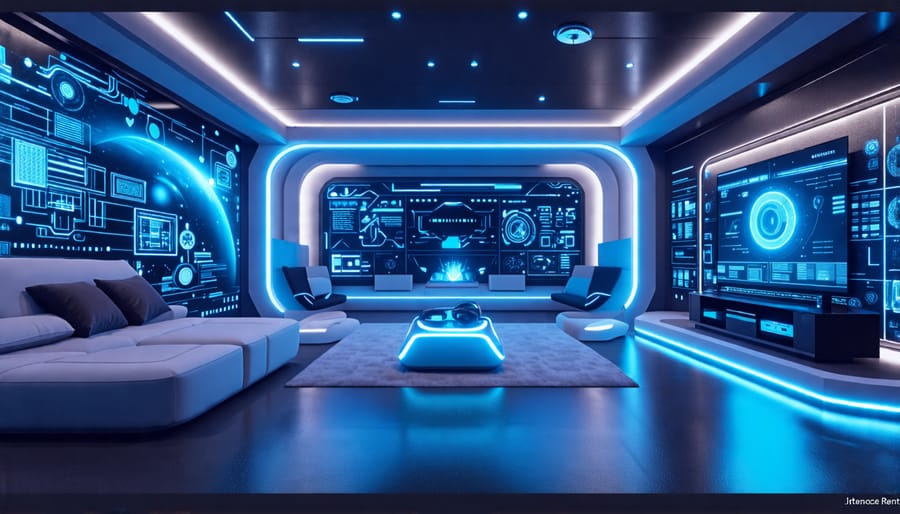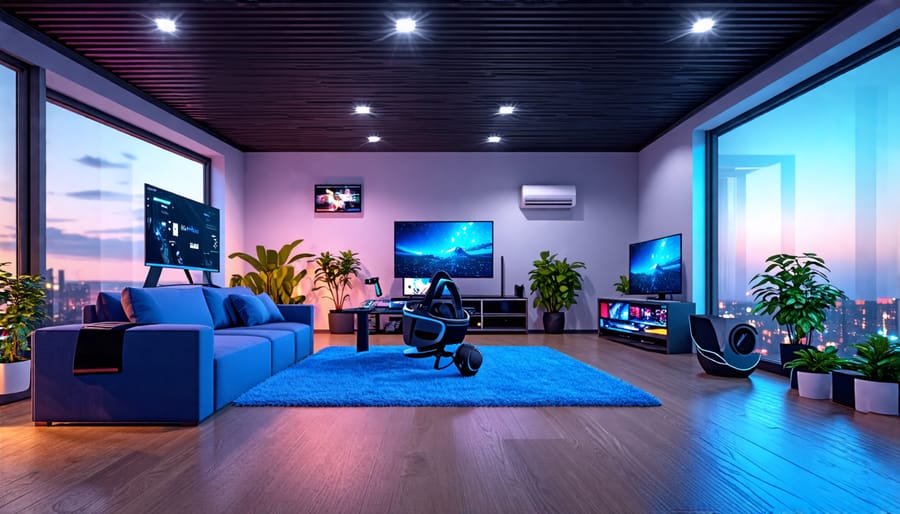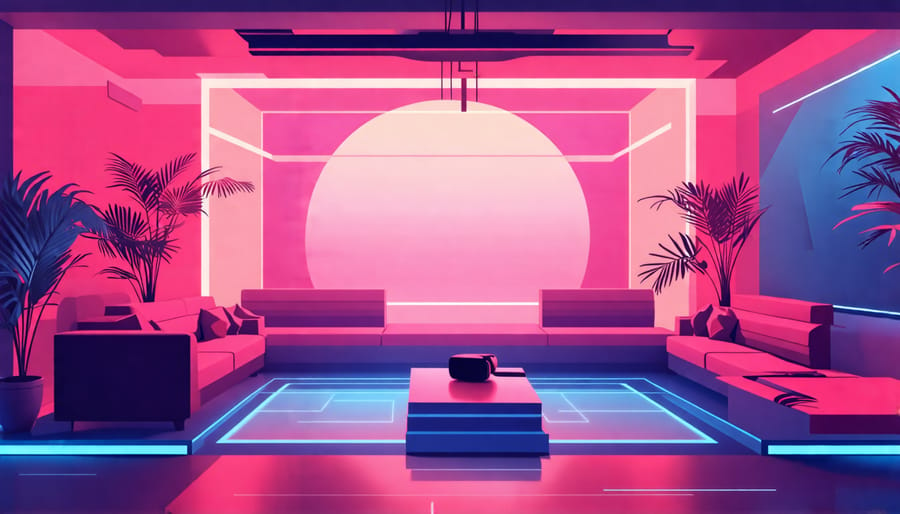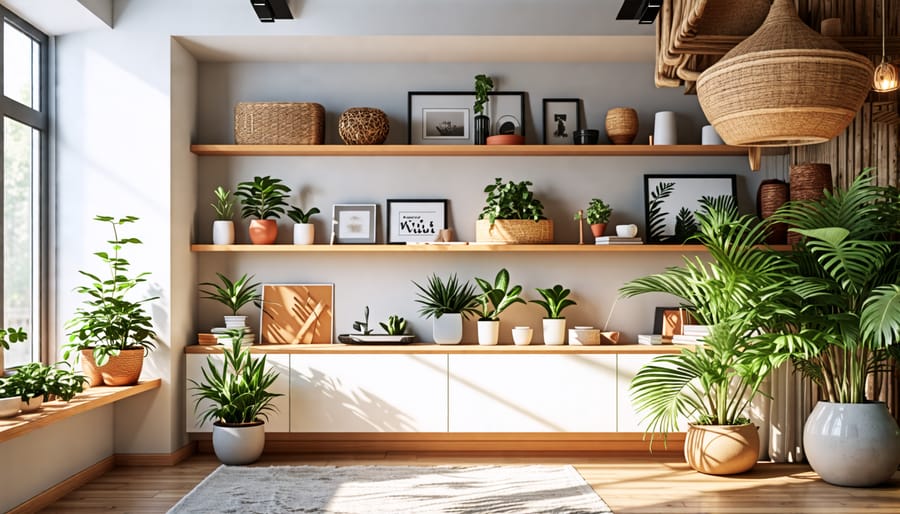
Step into the Future: Designing Your Perfect Virtual Reality Room
Install essential VR-compatible hardware by ensuring high-speed internet, powerful graphics, and spatial audio systems are in place. Arrange furniture to maximize open space, ensuring an unobstructed area for movement, and use adjustable lighting to enhance immersion. Choose washable, non-slip flooring to promote safety and easy cleaning, enhancing both functionality and comfort. Add personal touches like color-changing LED strips, thematic decor, or customized wall murals to reflect your style and elevate the VR experience.
The Essentials of a Virtual Reality Room
Choosing the Right Space
When creating the perfect virtual reality room, choosing the right space is essential for a fully immersive experience. Start by identifying a room with enough space for movement, ideally at least 10 feet by 10 feet, to accommodate various VR activities without constraints. An open floor plan is especially advantageous, allowing for seamless navigation through virtual environments. Additionally, consider ceiling height; taller ceilings enhance sound quality and overall room dynamics. For those with limited space, check out smart storage hacks to make the most of what you have.
Location matters too. Choose a room away from high-traffic areas and noise for optimal concentration and enjoyment. Make sure the chosen space provides flexibility for wiring and equipment set-up, while keeping distractions to a minimum. Lighting is crucial; opt for adjustable lighting options, facilitating both daytime play and evening sessions. Tailor the room’s aesthetics with cushioning or carpeting, enhancing both comfort and acoustic absorption. With these guidelines, you can create a VR haven that not only fits your physical space but also elevates your virtual experiences.
Key Equipment and Technology
Creating a virtual reality room that seamlessly blends technology and design starts with selecting the right equipment. At the heart of this setup are VR headsets like the Oculus Quest 2 or HTC Vive, which deliver immersive experiences, while high-performance gaming PCs power these devices and ensure smooth operation. To further enhance your VR room, consider integrating additional components like haptic feedback gloves and motion sensors, which can enrich interaction and involvement in virtual environments.
Additionally, don’t overlook the importance of spatial design elements such as adequate room space and furniture placement. Keeping the play area clear and obstacle-free is crucial for safety and immersion. It’s also worthwhile to explore the integration of smart home technology to control lighting and sound systems right from your headset, optimizing each VR session with ambient enhancements.
For DIY enthusiasts, setting up a VR room can be a rewarding project. Start by choosing versatile software options, such as SteamVR, that offer a wide range of applications. By blending the right technology with thoughtful room design, you can craft a dynamic virtual reality environment that resonates well with both personal style and technological innovation.

Safety and Comfort Considerations
When designing a virtual reality room, prioritize safety and comfort to enhance the immersive experience. Start by choosing flooring that offers a non-slip surface, like padded mats or carpet tiles, to prevent accidents during active gameplay. Good ventilation is crucial to keep the room well-aired and comfortable, especially during extended VR sessions. Consider installing a fan or air conditioning unit to maintain optimal temperature. Lastly, soundproofing the room using acoustic panels or heavy curtains can minimize external noise, ensuring users stay fully engaged in their virtual environment without distractions. These considerations make your VR experience enjoyable and worry-free.
Design Aesthetics for a VR Room
Color Schemes and Lighting
Creating an immersive virtual reality room begins with the right color schemes and lighting to enhance your experience and mood. Start by selecting soft, neutral tones for the walls, which can help to reduce distraction and keep the focus on your VR content. Shades like light grays, creams, or pale blues are ideal. You can add splashes of color through accessories or furniture to personalize your space and make it welcoming.
Lighting plays a pivotal role in setting the ambiance. Incorporate dimmable lights to easily transition between different moods, or use RGB lights for a dynamic effect that can be synced with your VR activities. To tackle any dark corners, explore these lighting tricks that bring life to sun-starved spaces.
Experiment with the placement of lights to avoid glare on screens or VR headsets, ensuring a seamless and immersive environment. Whether you’re a homeowner sprucing up your space or a DIY enthusiast at heart, focus on these elements to elevate your virtual reality journeys.

Furniture and Layout Considerations
Designing a virtual reality room involves thoughtful consideration of furniture and layout to ensure both functionality and aesthetic appeal. Begin by selecting furniture that is comfortable and non-intrusive. Opt for modular or lightweight pieces that can be moved easily or rearranged to suit different VR experiences. Sofas with detachable sections or bean bags can provide flexibility and coziness without cramping the space. Clearance should be a priority—make sure there’s adequate space around furniture to freely use VR equipment and to move safely without risk of collision.
Consider integrating smart furniture that enhances the VR experience. For instance, investing in an adjustable standing desk can offer a multipurpose use of the room and serve as a station for both work and VR gaming. Incorporating muted, minimalist designs can help keep the focus on the immersive technology rather than the décor itself, ensuring that the visual elements of VR aren’t overwhelmed by busy patterns or bulky furniture.
Lighting is another crucial factor in the layout. Use dimmable and indirect lighting to control the ambiance and prevent glare on VR headsets. You might even explore adding smart lights that can sync with your VR system for an enhanced experience.
Arranging your VR room should feel like setting a stage. Focus on creating a central open area that invites interaction and experimentation. This setup allows users to feel free within their virtual world, further blending reality with the immersive environment. By balancing style and practicality, you can craft a space that elevates both the functionality of VR equipment and the inviting nature of the room.
DIY Projects: Personalizing Your VR Room
Customize Your VR Setup
Creating a virtual reality room that’s both functional and tailored to your personal style is an exciting DIY project. Start by selecting a spacious room with minimal furniture to avoid accidental bumps or trips. Ensure the floor is clear and consider a soft carpet to cushion any potential falls. Next, focus on the equipment layout. Position sensors at different corners of the room for optimal tracking coverage. Mounting them high up on walls can provide a better range.
For the VR headset, designate a convenient spot for charging and safe storage when not in use. If you’re planning on frequent long sessions, invest in comfortable, easy-to-clean seating, like a lightweight stool that can be moved effortlessly. Finally, think about lighting. While bright, direct lights can interfere with sensors, ambient lighting can enhance the experience without causing disruptions. Personalize the walls with calming colors or inspiring artwork, creating a welcoming environment for your VR adventures.

Creative Decor and Accessories
When it comes to designing a virtual reality room, adding creative decor and accessories is an exciting way to bring your personality and interests to life. Begin by considering pieces that inspire you and reflect your style—whether that’s a love for travel, a passion for art, or a penchant for minimalist designs. For the eco-conscious, integrating elements from eco-friendly DIY initiatives can add a unique touch while being sustainable. Try creating wall art with reclaimed wood, or craft shelving from recycled materials to display VR gadgets and collectibles.
Lighting plays a crucial role in setting the mood. Opt for fixtures like LED strips or smart bulbs that can change colors to sync with your virtual experiences. To personalize further, add interactive elements such as a digital photo frame displaying VR adventures, or even VR-compatible interactive wall panels that respond to your touch, offering an immersive backdrop. Don’t shy away from using textures, too—think about incorporating soft rugs or bean bags to enhance comfort during long VR sessions. These thoughtful additions not only make your VR room a practical space but also a reflection of who you are.
Maintenance and Upgrades
Regular Maintenance Tips
To keep your virtual reality room and equipment in prime condition, regular maintenance is key. Start by keeping your VR headset clean using a microfiber cloth to gently wipe the lenses and surfaces. It’s important to avoid harsh chemicals that could damage the delicate parts. Dust and vacuum the room regularly to reduce debris that might harm your equipment or disrupt immersion. Ensure ample ventilation to prevent overheating; this not only protects your gear but also enhances your comfort.
Next, check cables for any wear and tear. Organize cords with ties or hooks to prevent tripping hazards and accidental disconnections. Inspect your VR hardware frequently, updating firmware as recommended to ensure optimal performance and security.
Adjust the room’s lighting; low ambient lighting works best for VR, minimizing glare without compromising visibility. Lastly, test your virtual boundaries routinely to avoid collisions, preserving both your surroundings and your peace of mind. By following these simple steps, you can enjoy an immersive VR experience for a long time.
Recognizing When It’s Time to Upgrade
If your virtual reality room feels cramped or outdated, it might be time for an upgrade. A major sign is when your current technology struggles with new VR experiences. If you’re experiencing lag or your headset isn’t compatible with the latest apps, consider updating your equipment. Additionally, consider redesigning if your space lacks comfort or functionality. Think about incorporating ergonomic furniture and optimizing room acoustics for an immersive audio experience. Decluttering the space and improving lighting can also refresh the ambiance. These changes not only enhance your VR setup but also make the room a more enjoyable place to be.
Conclusion: Embrace the Future of Home Entertainment
As we conclude this exploration into the future of home entertainment, it’s clear that virtual reality room design offers an exciting frontier for innovation right within our own homes. Embracing VR transforms the way we experience media, blending technology with personalized comfort to create immersive environments like never before. For homeowners and DIY enthusiasts, the possibilities are truly endless. Picture crafting a space that evolves with your needs—be it gaming, cinematic experiences, or virtual travel. Interior designers and real estate agents will also find the potential to capture imaginations, making properties stand out in the market. Whether you’re integrating the latest technology or working on a DIY project, stepping into the world of VR room design is all about creativity and innovation. It’s an invitation to experiment and redefine what entertainment means for you. So, as you consider your next project, remember that the future of home entertainment is dynamic and accessible. Dive in, explore, and let your imagination lead the way into these vibrant digital spaces where reality and fantasy seamlessly intertwine.
